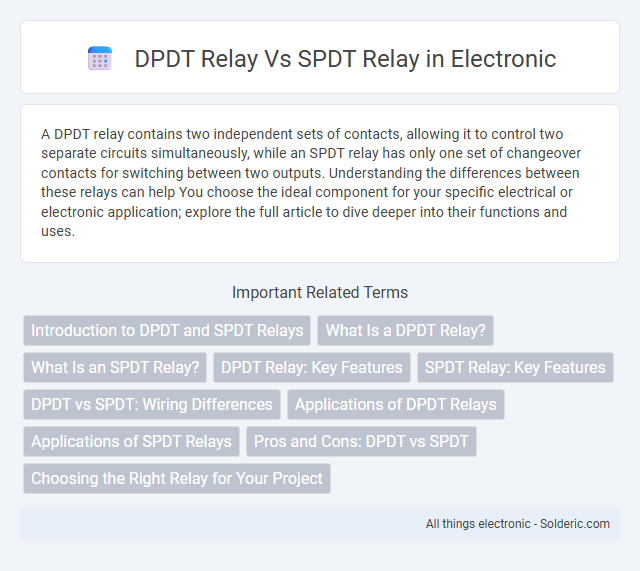A DPDT relay contains two independent sets of contacts, allowing it to control two separate circuits simultaneously, while an SPDT relay has only one set of changeover contacts for switching between two outputs. Understanding the differences between these relays can help You choose the ideal component for your specific electrical or electronic application; explore the full article to dive deeper into their functions and uses.
Comparison Table
| Feature | DPDT Relay | SPDT Relay |
|---|---|---|
| Full Name | Double Pole Double Throw | Single Pole Double Throw |
| Number of Poles | 2 | 1 |
| Number of Throws | 2 | 2 |
| Switching Capacity | Controls two circuits simultaneously | Controls one circuit |
| Applications | Complex switching, reversing motors, dual circuit control | Basic switching, ON/OFF toggling, single circuit control |
| Size | Larger, due to more contacts | Smaller, fewer contacts |
| Cost | Higher cost | Lower cost |
Introduction to DPDT and SPDT Relays
DPDT (Double Pole Double Throw) relays feature two separate circuits that can be switched simultaneously, allowing versatile control of multiple devices or complex switching configurations. SPDT (Single Pole Double Throw) relays operate one circuit with two output options, ideal for switching between two signals or power sources. Both types play crucial roles in automation, motor control, and signal routing applications, with DPDT offering greater functionality and SPDT providing simpler, cost-effective switching solutions.
What Is a DPDT Relay?
A DPDT relay (Double Pole Double Throw) is an electromechanical switch that controls two independent circuits simultaneously with a single coil, allowing each pole to connect to one of two outputs. This relay type provides versatility in switching applications, enabling control of multiple loads or reversing the polarity of a signal. Compared to an SPDT relay, which switches a single circuit between two outputs, a DPDT relay offers enhanced functionality for more complex electrical control tasks.
What Is an SPDT Relay?
An SPDT relay, or Single Pole Double Throw relay, features one common terminal and two output terminals, allowing you to switch a circuit between two different outputs. This relay type is ideal for applications requiring a single input to control multiple circuits, enabling seamless toggling without complex wiring. Compared to a DPDT relay, which has two poles and can control two separate circuits simultaneously, the SPDT relay offers simpler switching for single-circuit control needs.
DPDT Relay: Key Features
DPDT relays feature two sets of changeover contacts, allowing them to control two separate circuits simultaneously, which provides greater versatility than SPDT relays. These relays are ideal for applications requiring circuit switching between two different outputs or reversing motor directions. Your choice of a DPDT relay ensures increased control options and enhanced functionality for complex electrical systems.
SPDT Relay: Key Features
SPDT relay features a single pole with two throw positions, allowing it to switch between two circuits or signals efficiently. It provides reliable switching for control circuits with a common terminal and two outputs, enabling versatile applications like toggling between power sources or signal paths. Its compact design and straightforward operation make SPDT relays essential in automation, home appliances, and automotive systems.
DPDT vs SPDT: Wiring Differences
DPDT relays have six terminals corresponding to two separate poles, allowing control of two independent circuits simultaneously, whereas SPDT relays have three terminals for a single pole switch that toggles between two contacts. In DPDT wiring, each pole requires a dedicated coil switch connection, enabling more complex circuit configurations like reversing motor polarity or switching dual signals. SPDT wiring is simpler, suited for switching one circuit between two outputs, making it ideal for basic on/off or selection tasks in electronics and automation.
Applications of DPDT Relays
DPDT relays are essential in applications requiring circuit switching between two different outputs or reversing polarity, such as motor control systems and audio signal routing. They are widely used in automation equipment to control multiple circuits with a single relay coil, enhancing operational efficiency. Industrial machinery often employs DPDT relays for complex switching tasks where SPDT relays would be insufficient due to their single-pole configuration.
Applications of SPDT Relays
SPDT relays are widely used in applications requiring single-pole switching with two possible output states, such as controlling lighting circuits, activating alarms, and switching power supplies. Their ability to direct current between two separate circuits makes them ideal for motor control and signal routing in automation systems. You can rely on SPDT relays for precise switching tasks where compact size and reliable operation are essential.
Pros and Cons: DPDT vs SPDT
DPDT relays offer double-pole double-throw functionality, enabling control of two separate circuits simultaneously, which provides enhanced versatility compared to SPDT relays that switch a single circuit between two paths. The complexity of DPDT relays leads to a larger size and higher cost, while SPDT relays are more compact, cost-effective, and simpler to implement for basic switching tasks. However, SPDT relays lack the capability to control multiple circuits independently, limiting their application in complex electrical systems where DPDT relays excel.
Choosing the Right Relay for Your Project
Choosing the right relay for your project depends on the number of poles and throws required; a Double Pole Double Throw (DPDT) relay controls two separate circuits and can switch between two outputs, making it ideal for complex control systems. In contrast, a Single Pole Double Throw (SPDT) relay manages one circuit with two output options, suitable for simpler on/off or directional control applications. Consider the electrical load, switching requirements, and circuit complexity to ensure optimal relay performance and reliability.
DPDT relay vs SPDT relay Infographic

 solderic.com
solderic.com